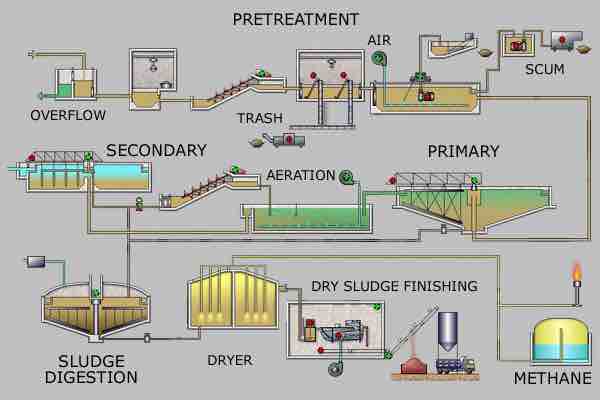Sewage is generated by residential and industrial establishments. It includes household waste liquid from toilets, baths, showers, kitchens, sinks, and so forth that is disposed of via sewers. In many areas, sewage also includes liquid waste from industry and commerce. The separation and draining of household waste into greywater and blackwater is becoming more common in the developed world. Greywater is water generated from domestic activities such as laundry, dishwashing, and bathing, and can be reused more readily. Blackwater comes from toilets and contains human waste.
Sewage treatment is done in three stages: primary, secondary and tertiary treatment .

Diagram of Sewage Treatment Process
Sewage passes through primary, secondary, and tertiary treatment.
Primary Treatment
In primary treatment, sewage is stored in a basin where solids (sludge) can settle to the bottom and oil and lighter substances can rise to the top. These layers are then removed and then the remaining liquid can be sent to secondary treatment. Sewage sludge is treated in a separate process called sludge digestion.
Secondary Treatment
Secondary treatment removes dissolved and suspended biological matter, often using microorganisms in a controlled environment. Most secondary treatment systems use aerobic bacteria, which consume the organic components of the sewage (sugar, fat, and so on). Some systems use fixed film systems, where the bacteria grow on filters, and the water passes through them. Suspended growth systems use "activated" sludge, where decomposing bacteria are mixed directly into the sewage. Because oxygen is critical to bacterial growth, the sewage is often mixed with air to facilitate decomposition.
Tertiary Treatment
Tertiary treatment (sometimes called "effluent polishing") is used to further clean water when it is being discharged into a sensitive ecosystem. Several methods can be used to further disinfect sewage beyond primary and secondary treatment. Sand filtration, where water is passed through a sand filter, can be used to remove particulate matter. Wastewater may still have high levels of nutrients such as nitrogen and phosphorus. These can disrupt the nutrient balance of aquatic ecosystems and cause algae blooms and excessive weed growth. Phosphorus can be removed biologically in a process called enhanced biological phosphorus removal. In this process, specific bacteria, called polyphosphate accumulate organisms that store phosphate in their tissue. When the biomass accumulated in these bacteria is separated from the treated water, these biosolids have a high fertilizer value. Nitrogen can also be removed using nitrifying bacteria. Lagooning is another method for removing nutrients and waste from sewage. Water is stored in a lagoon and native plants, bacteria, algae, and small zooplankton filter nutrients and small particles from the water.
Sludge Digestion
Sewage sludge scraped off the bottom of the settling tank during primary treatment is treated separately from wastewater. Sludge can be disposed of in several ways. First, it can be digested using bacteria; bacterial digestion can sometimes produce methane biogas, which can be used to generate electricity. Sludge can also be incinerated, or condensed, heated to disinfect it, and reused as fertilizer.